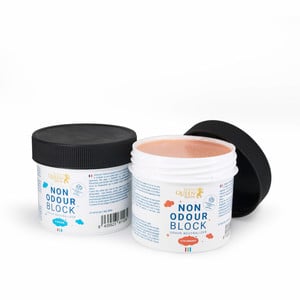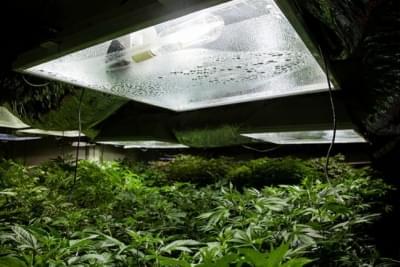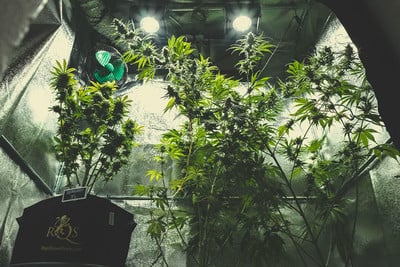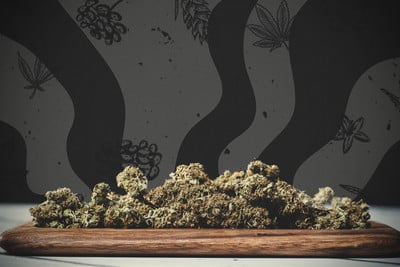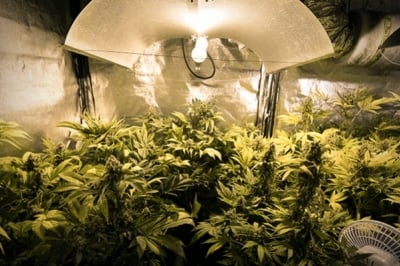.

How To Control The Smell of Cannabis
Unless you're lucky enough to live in a tolerant country or state, chances are growing cannabis remains illegal where you live. To keep your plants safe and your hobby private, you need to keep those smelly terpenes under control—almost everybody knows the smell of weed. Use the strategies below to limit their spread to your growing space.
How to hide the smell of your weed plants.
Contents:
Cannabis has one of the most easily-recognised scents out there, which is amazing until you need to cover it up.
Every strain offers a different cocktail of terpenes, but the earthy and gassy scent we know and love always comes to the fore. Such a distinct smell makes using the herb a pleasant experience, but it also attracts attention, drawing in unwanted eyes and noses.
Keeping the scent under control can be tough, but it’s certainly possible, and we’ll show you how it’s done. Find out how to keep your weed plants under the radar using the tips below.
Why Is Odour Control So Important?
Unfortunately, cannabis remains illegal in many parts of the world.
Growing the herb at home comes with many rewards, including the satisfaction of smoking your own weed and saving a bunch of money during the process. However, it also comes with a significant risk depending on where you live.
Some growers live in regions where they’ll receive a warning and a slap on the wrist if they get busted. Others face more serious consequences, including getting evicted by their landlord or ending up in jail.
In turn, cannabis growers take creative measures to keep their botanical passion clandestine. Some cultivators cover up their windows to prevent the obvious glow of pink and blue LED lights. Others go to the lengths of converting cupboards and computer towers into mini grow rooms to keep their plants hidden and secure.
These techniques are effective at keeping a crop under the radar, but the smell of flowering weed remains the most obvious give away. Cannabis terpenes are powerful enough to stink out an entire apartment block if left unchecked. Growers must do everything they can to prevent terpenes from leaking out of their growing space if they want to stay undiscovered.
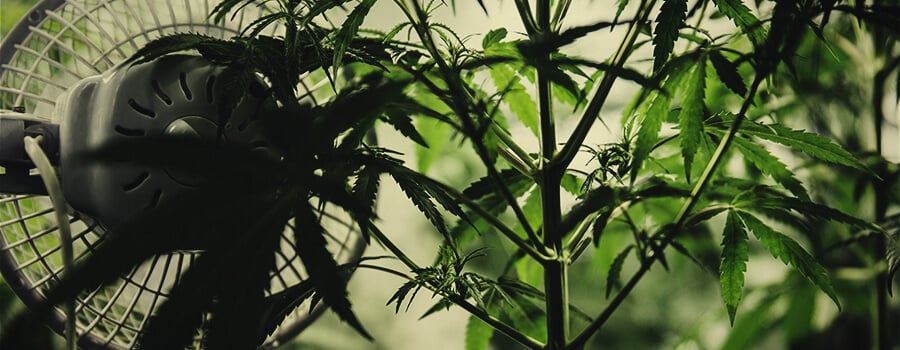
When Do Cannabis Plants Start Smelling?
Thankfully, cannabis plants don’t stink throughout the entire growing cycle. In fact, they remain entirely scent-free during the seedling and vegetative phase. During these stages of growth, plants direct all of their energy toward getting as big as possible to house future flowers.
Eventually, though, the vegetative phase must come to an end. Depending on the type of plant, a shift in the daylight hours, or an internal genetic mechanism, will initiate the flowering stage. Over the course of the next few weeks, you’ll notice your plants stretch and show the first signs of flowering: small hair-like pistils at the nodes. As these become flowers that grow into full-sized nuggets, they’ll start to stink more and more.
This increasing intensity is caused by another key development, specifically those small crystal-like structures you’ll notice on the surface of cannabis flowers. Known as trichomes, these mushroom-shaped glands churn out a resin that’s rich in cannabinoids and smelly terpenes. This resin, in turn, protects the plant from insects and fluctuating temperatures. Your flowers will begin smelling as soon as your plants start producing this resin, and will stay stinky well after you harvest them.
What Covers The Smell Of Cannabis?
Growing cannabis without any means of odour control will certainly turn some heads. If you live out in the sticks, you might get away with it. But you’ll be playing a risky game if you live in the suburbs—even more so if you live in an apartment complex.
Fortunately, cannabis growers are an innovative bunch. After dealing with draconian measures for decades, green-fingered cannabis lovers have developed tried and tested methods of covering up the obvious smell of the herb.
-
Carbon Filter and Extractor Fan
Cannabis plants need to breathe. Therefore, you need to ensure your growing space features a constant flow of fresh air. However, the air that leaves the growing space will take a boatload of terpenes along with it—unless you process it.
The combination of a carbon filter and an extractor fan works by diverting and scrubbing outgoing air to rid it of skunky terps. Whether you’re growing in an open room or an enclosed growing tent, you should position an extractor fan next to the air vent of your dedicated space. This device will pull air towards it and form a current that prevents smelly air from leaking out of doors or windows.
By attaching a carbon filter to the extractor fan, you’ll capture the terpenes as the air leaves the growing space. These filters work using the principle of adsorption. Terpene molecules stick to the large surface area of carbon molecules as the air passes through the device.
Carbon filters are easy and cheap to make at home. Just make sure you match the requirements of the carbon filter to the extractor fan.
.jpg)
-
Air Purifier
Air purifiers work by drawing air through a series of fine filters. As a fan sucks the air through, small particles and pollutants get trapped in the filters and clean air passes through the other side. Air filters create steady airflow and will provide a clean and fresh environment for your plants.
As far as smell goes, air purifiers do make a bit of a difference. However, they certainly aren’t a panacea. We recommend including them as part of an odour-prevention strategy, as opposed to relying on them as an independent solution.
-
Low Odour Cannabis Strains
Some strains just don’t smell as much as others. Just as cannabis breeders have developed some cultivars to produce sky-high levels of terpenes, the botanical masterminds have also created varieties with subtle smells designed for covert growing. Some of the best low odour genetics include:
-
Companion Planting
Companion planting involves sowing beneficial species in close proximity to your weed plants. Although largely practised outdoors, indoor growers also utilise the power of companion plants to protect their crop and cover-up suspicious smells. Companion planting comes with a whole host of benefits. Several species generate terpenes of their own that help to repel hungry pest species with an appetite for weed. Other companions emit smells that help to attract beneficial insects that help to take down pest populations.
Many species of companion plants generate odours that are almost as powerful as cannabis. For example, a mix of lavender, basil, and chamomile does a great job at masking cannabis terpenes that would otherwise run riot. Companion plants also work wonders outdoors at keeping cannabis plants out of sight, as well as masking their scent. Taller species such as yarrow and sunflowers will keep your plants undercover.
-
Ozone Generators
Ozone generators may help to reduce smells by reacting with odorous chemicals, including terpenes. These devices create ozone by breaking oxygen molecules, by way of UV radiation or electric discharge, allowing single atoms to bind with other O2 molecules. However, a lack of evidence has led to scepticism within parts of the growing community. The possibility of these devices creating harmful byproducts also understandably puts a lot of growers off using them.
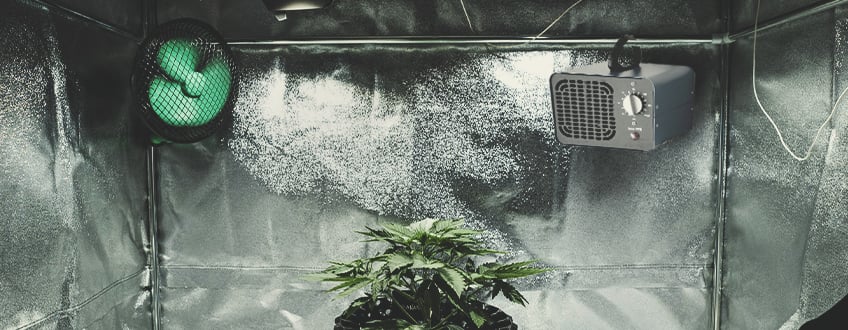
-
Odour Neutralisers and Gels
Odour neutralisers, gels, and blocks work particularly well at removing the smell of weed. These products are easy to use, require almost no space, and work almost instantly. Odour neutralisers don’t simply mask the smell of weed, they actually strip it from the air through the mechanisms of absorption, adsorption, and chemical reaction.
Despite their effectiveness, growers need to use these products with caution. Never place them inside the same room or tent as your plants, as they can change the taste and smell of flowers over time. Instead, place them outside of the growing space to intercept odours that leak out.
-
Enclosed Grow Rooms and Tents
Raising your plants in an enclosed room or tent will help to prevent leaks seeping out of cracks and gaps and into the hallways or outdoors. All of the interventions above work to a degree, but leaks can render them ineffective. Ensure a secure growing area before you plants enter the flowering stage.
-
Plan Ahead
Assess your growing situation before you introduce seeds to soil. How much space do you have available? What are the repercussions if you’re caught? Can you get away with a few leaks here and there? Or will one whiff be game over?
You need to decide what you can get away with before you start your grow. Bigger plants give off more intense smells, but they’ll offer great yields if you can pull it off. If your situation appears particularly risky, keep your grow small and opt for small plants that are easy to conceal.
Cannabis Odour Control—Final Thoughts
Smelly terpenes are one of the most common reasons growers get busted. You should develop your odour strategy before germinating seed to give you ample time to obtain equipment and set it up. Although going out of your way to trap odour might seem like a hassle at first, it will provide peace of mind throughout the entire grow.


























